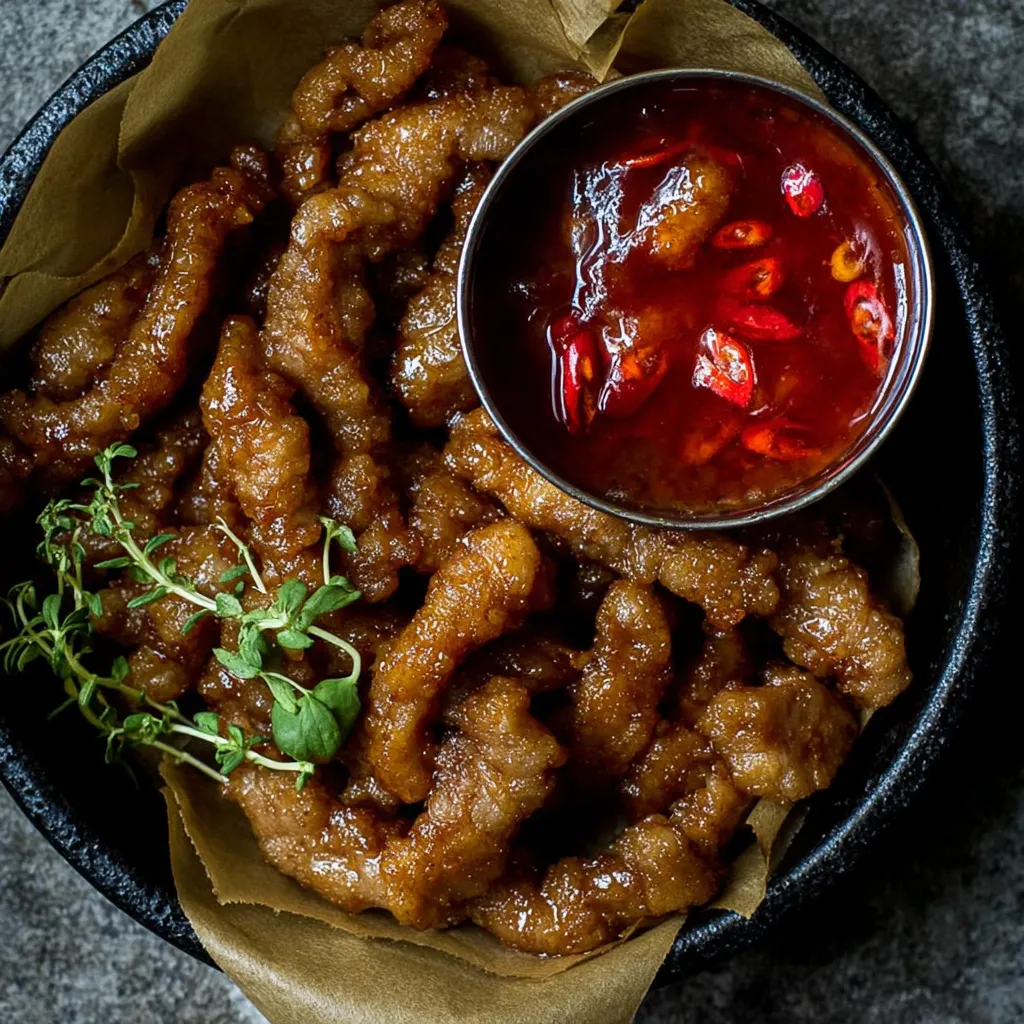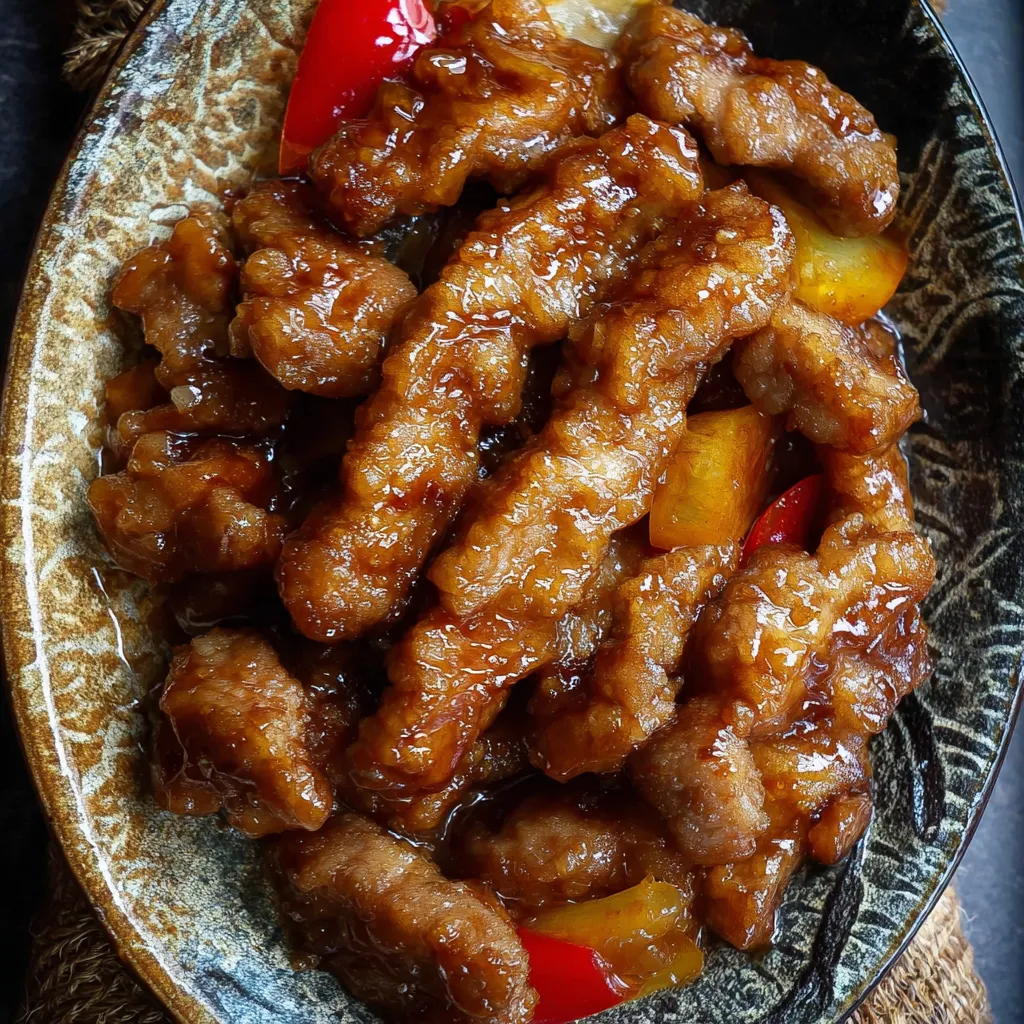 Save
Save
This authentic Chinese sweet and sour pork recipe delivers that perfect balance of crispy exterior and tender, juicy meat that's even better than takeout. The overnight marination ensures deep flavor penetration, while the careful ratio of cornstarch to flour creates that signature crispy coating we all crave.
I first made this recipe after returning from a trip to China where I fell in love with authentic sweet and sour pork. After multiple experiments, this version finally captured that perfect balance of flavors that transported me right back to that small restaurant in Shanghai.
Ingredients
- Pork scotch cut: pork scotch retains moisture when deep-fried due to its natural fat content creating juicy bites
- Chinese dark vinegar: provides that authentic tangy flavor foundation for the sweet and sour profile
- Soy sauce: adds umami depth to the marinade quality brands like Leekumkee make a noticeable difference
- Sugar: balances the acidity of the vinegar creating that classic sweet and sour harmony
- Five spice powder: infuses the dish with authentic Chinese aromatics a little goes a long way
- Rice wine: tenderizes the meat while adding subtle complexity to the marinade
- Cornstarch: creates that light crispy exterior that stays crunchy even after saucing
- Flour: works with cornstarch to achieve the perfect textural contrast
- Oil for deep frying: needs to be at the right temperature for proper crispiness
Step-by-Step Instructions
- Marinating the Pork:
- Combine pork pieces, Chinese dark vinegar, soy sauce, sugar, five spice powder, and rice wine in a container. Mix thoroughly to ensure each piece is coated. Cover and refrigerate overnight allowing the flavors to penetrate deeply into the meat. The acidic vinegar will begin tenderizing the pork while the aromatics infuse throughout.
- Creating the Coating:
- Remove the marinated pork from the refrigerator. If you prefer an extra crispy coating, drain approximately half of the marinade liquid first. Add cornstarch and flour to the pork, tossing gently until each piece is thoroughly coated. The coating should adhere well to the meat without being too thick or too thin. Let stand for 5 minutes to allow the coating to set.
- Deep Frying to Perfection:
- Heat oil in a large saucepan or small pot to approximately 350°F. Test by dropping a small bit of batter if it immediately sizzles and rises to the surface, the oil is ready. Carefully add pork pieces in small batches, avoiding overcrowding which would lower the oil temperature. Fry until each piece develops a deep golden brown color and crispy texture, approximately 3 to 4 minutes. Remove with a slotted spoon and drain on paper towels.
My favorite part of this recipe is the five spice powder. When I first tried this dish in a small family restaurant in Guangzhou, I was captivated by the complex aroma. The cook showed me how just a small amount of this powerful spice blend transforms the entire dish, creating layers of flavor that dance on your tongue.
Choosing the Right Pork Cut
While the recipe calls for pork scotch cut, you have options depending on your preference. Pork scotch (also called pork neck or pork collar) offers the perfect balance of lean meat and fat, resulting in juicy pieces that remain tender after frying. If you prefer a leaner option, pork tenderloin works beautifully though it may be slightly less moist. Avoid overly lean cuts like loin chops as they can become tough when deep fried.
Vinegar Variations
The Chinese dark vinegar or Zhenjiang vinegar is crucial for authentic flavor, but substitutions are possible if you cannot find it. Balsamic vinegar makes an excellent alternative with its similar sweet-sour profile and rich color. For a lighter flavor, rice vinegar mixed with a small amount of molasses can approximate the taste. The vinegar provides the signature tang that defines sweet and sour dishes, so choosing the right one significantly impacts your final result.
Serving Suggestions
Traditional Chinese sweet and sour pork pairs beautifully with steamed jasmine rice, which absorbs the delicious sauce. For a complete meal, serve alongside stir-fried vegetables like bell peppers, pineapple chunks, and onions. The colorful vegetables not only add nutritional value but also complement the rich flavors of the pork. For an authentic Chinese family-style meal, present this dish alongside hot and sour soup, steamed dumplings, and a simple green vegetable stir-fry with garlic.
Storage and Reheating
Store any leftover sweet and sour pork in an airtight container in the refrigerator for up to three days. The flavor actually improves overnight as the ingredients meld together. To maintain the crispy texture when reheating, use an air fryer at 375°F for 3-4 minutes or a conventional oven at 350°F for 8-10 minutes. Avoid microwave reheating as it will make the coating soggy. For longer storage, freeze the cooled pork pieces on a baking sheet individually before transferring to a freezer bag, where they'll keep for up to three months.
 Save
Save
Recipe FAQs
- → What cut of pork works best for sweet and sour pork?
Pork scotch is ideal as its natural fat content helps retain moisture during deep-frying, resulting in juicy pieces with excellent flavor. For a leaner option, pork tenderloin works well but may be slightly less moist.
- → Can I substitute Chinese dark vinegar with something else?
Yes, balsamic vinegar makes an excellent substitute for Chinese dark vinegar (ZhenJiang vinegar) in this dish. The slight sweetness and acidity of balsamic provides a similar flavor profile to achieve that authentic taste.
- → How do I get the crispiest coating on the pork?
For the crispiest coating, drain half of the marinade before adding the cornstarch and flour. Use a 2:1 ratio of cornstarch to flour, but you can increase the flour proportion for extra crunchiness. Ensure your oil is hot enough that the pork sizzles immediately when added.
- → How long should I marinate the pork?
For best results, marinate the pork overnight in the refrigerator. This allows the flavors to fully penetrate the meat. However, if you're short on time, a minimum of 4 hours will still impart good flavor.
- → What's the perfect sauce ratio for balanced flavor?
The ideal ratio for a well-balanced sweet and sour flavor is 2:1:1 of vinegar to soy sauce to sugar. This creates the signature tangy-sweet profile that makes this dish so popular. Feel free to adjust slightly based on personal preference.
- → How can I store leftovers?
This dish is excellent for batch cooking. Store cooled leftovers in airtight containers in the freezer for up to 3 months. For best texture when reheating, thaw completely and then heat in a wok or skillet rather than microwave to maintain some crispness.
